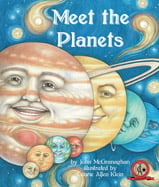Alignment to Standards for DC

| Grade | Number | Standard |
|---|---|---|
| 3 | SC.3.3. | Objects in the sky move in regular and predictable patterns. |
| 3 | SC.3.3.3. | there are more stars in the sky than anyone can easily count, but they are not spaced or spread evenly. |
| 3 | SC.3.3.4. | Observe and describe that the sun can be seen only in the daytime; the moon can be seen sometimes at night and sometimes during the day. |
| 3 | SC.3.3.5. | Observe and describe the changes that occur in the observable shape of the moon over the course of a month (i.e., the moon looks a little different every day, but looks the same again about every four weeks). |
| 5 | SC.5.3. | The solar system consists of planets and other bodies that orbit the sun in predictable paths. |
| 5 | SC.5.3.1. | Describe the Earth as part of a system called the solar system, which includes the sun (a star), planets, comets, asteroids, and many moons. |
| 5 | SC.5.3.2. | Recognize that the Earth is the third planet from the sun in our solar system. |
| 5 | SC.5.3.4. | Describe that, like all planets and stars, the Earth is approximately spherical in shape. |
| 5 | SC.5.3.6. | Observe how telescopes are used both to magnify images of distant objects in the sky, including the moon and the planets, and to gather enough light from very dim objects to make them visible. |
| 5 | SC.5.3.7. | Observe and describe that stars vary in size, but they are so far away that they look like points of light. |